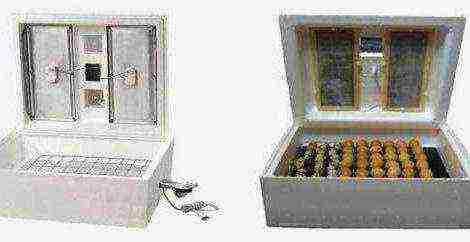Content
Breeding Peking ducks at home
The Peking duck is one of the most widespread breeds in the world. The meat breed was bred by selection in the 18th century in Beijing. It quickly spread throughout China and took a dominant position. After some time, the bird was brought to America and Europe. Due to its high productivity and excellent meat qualities, the Peking duck has supplanted many aboriginal breeds and today it is bred at home.
Description of the breed
Torso has an elongated and raised appearance. Body type powerful, wide chest, long back, tail raised. A large, tall head rests on a thick, arched neck, with a convex frontal region. Short thick legs are located closer to the tail and have an orange-red color. Wings strong, close to the body, stand out for their power and large scope. Dark blue, large, shiny eyes... Orange beak of medium size, slightly curved. Plumage white, high density. Muscle differs in significant density, a small layer of connective tissue. For a detailed description, characteristics and reviews of farmers about the breed, see below.
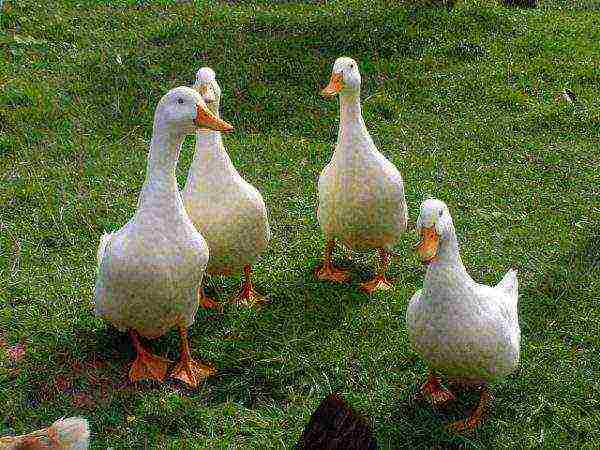
Peking duck is characterized by restless temperament, which is due to its rapidly excitable nervous system. The bird often screams, which causes a little trouble for some breeders. To avoid noise for ducks, they create favorable and calm conditions of existence, if all external stimuli are eliminated, the bird behaves calm and quiet.
Conditions of keeping and growing
The cultivation of Peking ducks, both in industrial and household farms, is quite simple and profitable business. Knowing the basic nuances and observing content requirements and feeding can be successful in record time.
On an industrial basis the bird is kept in specially equipped premises. The poultry houses are equipped artificial lighting, heating, automatic feed and water supply. The microclimate is monitored, and all sanitary and hygienic standards are observed.
In household plots for Peking ducks, poultry houses are being built or existing premises are being adapted. The house must be made of bricks, no cracks or holes. If possible, the room is insulated, which allows you to reduce heating costs in the winter. Heat should not escape through the roof or floor, if the windows are old, then they must be repaired. Rooms with earth or wood floors are not allowed. The floors are made of concrete. Good sex not only keeps warm, but also prevents rats from entering the barn, which can cause irreparable harm to the bird.
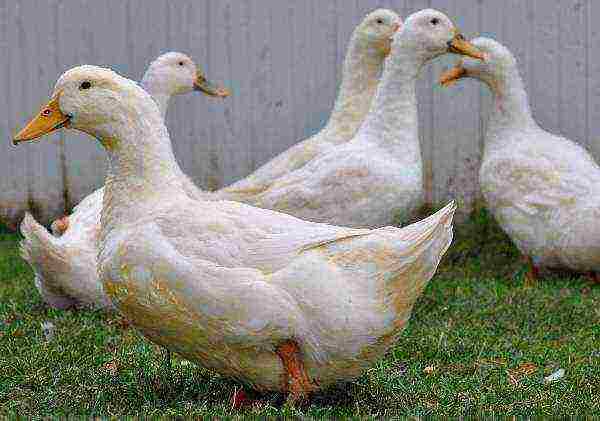
Laz is made in the south side, the hole should be well closed by a door and is at a height of 5-8 cm from the floor.The height of the manhole is 30-40 cm, and the width is 40 cm.If the duck is kept on the litter, the manhole is increased by 20-40 cm. high productivity birds need normal lighting. Artificial lighting is installed at the rate of 5 watts per 1 square meter of floor. Reflectors are hung on the bulbs. Concerning natural light, then 1 sq. m of floor should be 100 cm2 of windows. In winter, due to a lack of light, egg production decreases, so daylight hours are extended to 12 hours a day due to artificial lighting.
Every poultry house must have nests, they are made from plywood or wood. Normal socket parameters: 40x50, height 50 cm. At the entrance to the nest, a threshold of 8-10 cm is made. Nests are placed along the side walls of the house in dark places so that the duck is not disturbed by other birds.
Feeders are made of wood, the thickness of which is 2-2.5 cm. Since birds often scatter feed, a bar is attached on top so that the duck cannot climb inside. Length of feeders for adult birds - 110 cm, and for young stock 100. Width for adults 23 cm, for young stock 14.5 cm. Feeders are made with several compartments so that mineral feed can be dispensed. Vacuum drinkers are recommended for both juveniles and adults.
In the summertime, the Peking duck is advisable keep on walks and drive it into the room only for the night. On the walks, as in the poultry house, they are installed feeders, and if there is no access to the reservoir, then drinkers... Summer maintenance allows you to reduce the cost of funds at the expense of grass and reduce labor costs per unit of production.
In the poultry house no drafts allowed... In winter, the temperature should not drop below 5 ° C. Optimum temperature in the poultry house 16 ° C, with a humidity of 60-70%. Thanks to the downy cover, ducks endure frost and retain heat at the expense of their own bodies. Low temperatures are poorly tolerated if the bird has dirty plumage. The cleanliness of the ducks is directly dependent on the condition of the house, which must be regularly cleaned and ventilated. As deep beddingand use sawdust, straw, shavings and flax. The deep litter maintains a normal house climate, absorbs moisture well and generates heat due to the breakdown of organic matter. 20 kg of litter is used for 1 head per year. Placement rate for 1 sq. m: 2-3 adults or 6-8 heads of young animals.
In addition to outdoor keeping, Peking ducks can also be grown in cages. The cells are placed in the house in several tiers, the floor is made of slats or mesh so that the bird's legs do not fall through the holes. With this content, ducks eat well, move little and grow quickly, which makes it possible to get profit much faster.
Characteristics of the breed
Drake live weight - 3.6-4.2 kg, ducks - 3.4-3.9 kg. At 2 months of age, young animals weigh 2.2-2.6 kg. Ducks begin to lay eggs at 23 weeks, laying duration 42 days, hatchability 85-88%. Egg production - 100-140 eggs per year. Large eggs - 85-90 g. Shell thickness - 0.38 mm. High egg production is maintained for 2-3 years. The daily feed requirement for 1 head is 340 g. Slaughter yield - 67%. Body temperature 42.2 ° C, ducks breathe with a frequency of 30-34 respiratory movements per minute. 5 ducks are assigned to 1 drake, i.e. the family consists of 6 individuals.
Breeding and feeding
When feeding a Peking duck, it is necessary to take into account the structural features of this breed. Peking ducks have an accelerated metabolism... The small intestine facilitates the rapid assimilation of food (in 4 hours). Given these nuances, the bird must be constantly provided with food, which, in turn, contributes to the rapid weight gain.

Peking ducks well grow on ground feed and compound feed. The ratio of feed to water is 1k4. One adult per day has an average of 1 liter of water. Birds are sensitive to feed changes and feeding disturbances.
Feeding occurs 3 times a day. Wet food is given in the morning and in the afternoon, and cereals in the evening, in accordance with the norms and rations of feeding. Mash are prepared immediately before feeding and are given fresh, in no case should sour foods be fed. During the feeding period, the bird must have free access to water... On average, a duck per day should receive 80 g of oats, 75 g of barley, 60 g of bran, 40 g of fodder beets, 15 g of lentils or peas, 40 g of greens, 11 g of animal feed, 4 g of bone meal, 9 g of chalk and 1 g table salt.
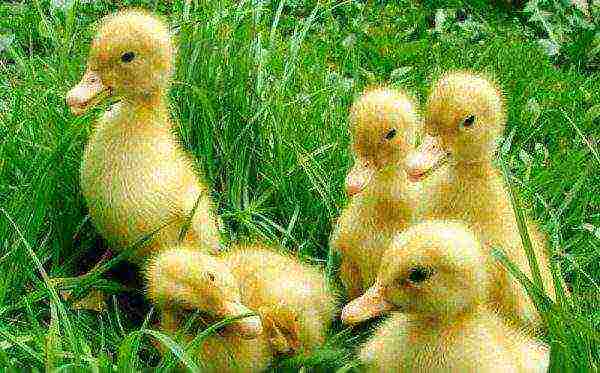
Feeding of the chicks begins after the plumage has dried. In the early days give a chopped boiled egg, it is possible with the addition of cottage cheese. After a few days starting compound feed and finely chopped greens are introduced into the diet. You need to feed babies at least 5 times a day. As a mineral dressing, ground eggshells are suitable. Young growth should be provided with vitamin supplements.
Diseases and care
Despite the fact that Peking ducks are hardy bird breeds, they are still susceptible to some diseases.
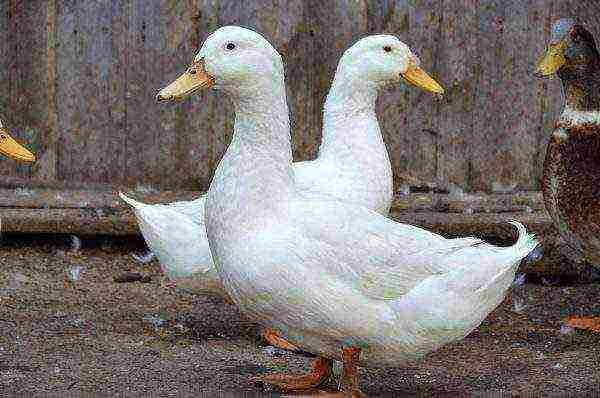
Avitaminosis
At avitaminosis birds become lethargic, appetite disappears, coordination of movement is disturbed, growth slows down, wings sag, eyes become inflamed, convulsions appear and fluid is released from the nostrils. Lack of vitamin D can lead to rickets. A balanced diet is the only way to combat vitamin deficiency, and if a bird develops symptoms of the disease, then there is a lack of any element in the feed.
Goiter diseases
The cause of the disease may be sticky food, swallowing foreign objects or large food. If the bird is not immediately helped, then the disease can go into a chronic stage and the goiter will stop shrinking. If the goiter is blocked, you must try to clear it yourself, holding the duck by the legs upside down. If the problem is serious, then it is highly recommended to call veterinarianwho will open the goiter.
Coccidiosis
Infectionleading to lethargy, decreased egg production, poor appetite, and bloody, frothy stools. Transmitted through food and feeding equipment. The first diseased individual must be isolated from the general herd. To prevent coccidiosis, coccidin and sulfadimezin are added to the water. Infected poultry house disinfect with a 3% formalin solution and a weak solution of potassium permanganate.
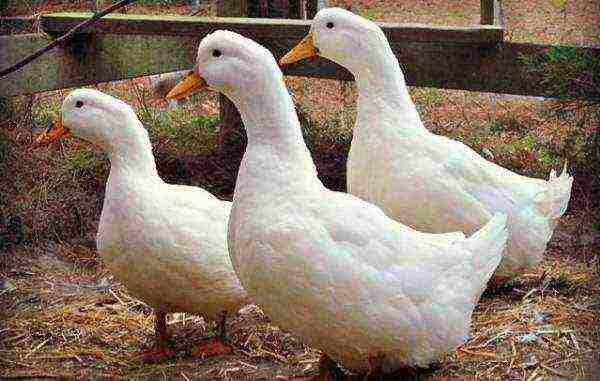
Aspergillosis
This disease most commonly affects ducklings and can lead to large fall of young... With aspergillosis, ducks have difficulty breathing, wheezing appears, fluid is released from the beak, birds convulsively swallow air, appetite decreases, growth slows down, paralysis of the legs or wings is possible. To eliminate the disease, all remains of feed and bedding are thrown away, equipment and the poultry house are disinfected. The feed is added nystatin, and in water a solution of 0.05% copper sulfate.
Pasteurellosis or cholera
This disease, although infrequent, is very serious. It transmitted through the air, feed and inventory. With cholera, ducks become apathetic, body temperature rises, thirst appears and appetite disappears, frothy discharge, loose stools with blood come from the nose. Infected birds are killed, their place of stay is disinfected. Healthy but contacting birds with infected individuals, biomycin is injected, and sulfadimezin is given.
Advantages and disadvantages of the Peking duck breed
Advantages:
- Good adapt to cold weather.
- They are distinguished by high early maturity.
- Unpretentious in feeding.
- There is no urgent need for maintenance reservoirs.
Flaws:
- Ducks are not prone to hatching.
- Get sick and fall to their feet in dampness.
Peking duck - this is one of the best and unpretentious meat breeds. It is distinguished by high productivity and good meat qualities... Ideal for industrial and domestic breeding, and due to early maturity, the period of profit is reduced several times compared to other breeds.
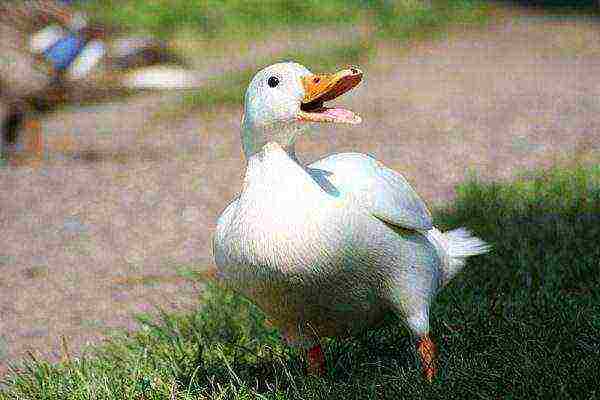
Reviews
The Peking Duck is the best option if you want to breed a beef breed. Gutted carcass weighs 2-2.5 kg. Young meat is very tasty and not tough. The percentage of fat is normal, there is just a little of it and, at the same time, the meat is not dry. It is better to hatch in an incubator, since there is little sense from a brood hen. On average, 8 healthy and viable chicks hatch out of 10 eggs. IN Peking ducks feed you should not limit, but you do not need to give a lot of food either, since they like to throw it around. Water should be constantly, and if possible, it is better to release it into the reservoir. If you breed it for yourself, then by the fall you can get a full-fledged duck, ready for slaughter.
White beautiful Peking ducks have become a favorite breed of many farmers. They are do not require special expenses for maintenance and feeding. Ducks give a year 120 eggsthat are perfectly incubated. They grow very quickly, and at 2 months weft weight already reaches 3 kg. Feed is consumed in moderation, and if you purchase modern feeders, then its consumption will be much reduced. Birds tolerate well low temperatures, and in the insulated poultry house you have to heat only in severe frosts. In general, it is very profitable to grow Peking ducks, and most importantly, quickly and with minimal cost and maintenance.


